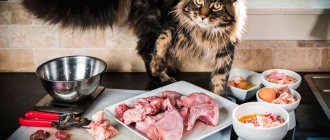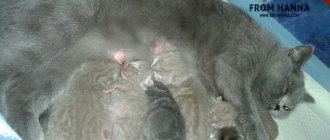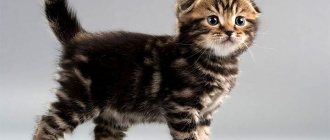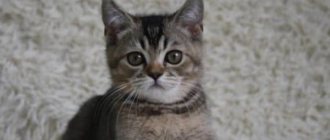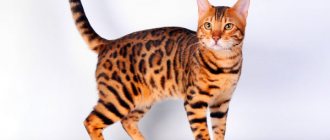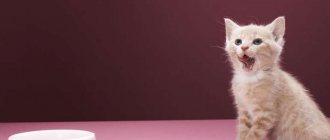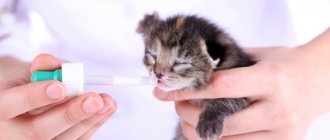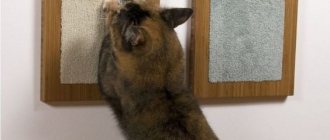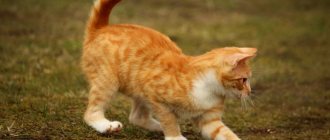Features of the Sphinx and its menu
Hairless cats need to move a lot to warm their bodies, so they eat everything.
Hairless cats need to move a lot to warm their bodies, so they eat everything to accumulate calories. Owners of the breed will have to make sure that harmful products are out of the pet’s reach: trash cans are closed, medications are hidden.
Another feature of sphinxes is that they do not chew food. Food should be cut into convenient portion pieces, and hard granules should be softened so that the animal cannot injure the esophagus in the process.
Cats have a delicate gastrointestinal tract; not all foods are suitable for them. It is important to monitor possible disorders and promptly remove foods that cause discomfort from the diet. Due to unbalanced nutrition, dermatitis and dysbacteriosis appear.
Special skin care
Since Sphynx kittens are hairless, the production of sebaceous glands accumulates on the skin, especially in the folds. Don't forget to wipe your baby with a damp cloth. If mistakes were made and a greasy crust formed, regular baby cream will help remove it. It is applied to the damaged area. And after a while it can be removed with the same napkin. Special oils or creams help restore your kitten's flaky skin. Because often, due to high room temperatures, the skin can dry out and begin to peel.
If a kitten has black spots on its skin, it is better not to self-medicate, but to consult a veterinarian. He will show you how and with what to deal with them correctly.
Rules for feeding kittens
Babies are sold in nurseries at 2-3 months, when they can already feed themselves.
Babies are sold in nurseries at 2-3 months, when they can already feed themselves. Breeders create an initial diet for kittens, but it is not necessary to adhere to it in the future.
In clubs, cats are fed commercially prepared products; owners often switch their pets to natural feeding. In order not to spoil the functioning of the gastrointestinal tract, a smooth transition is organized by feeding the animal with new components of the diet.
Attention! It is forbidden to mix dry and homemade food. Food varies in density and requires the production of different enzymes, which disrupts digestion and metabolism.
Up to 3 months, food is given 6-7 times, 25 g each. As the cat grows older (by the age of one year), the cat is transferred to two meals a day, 50 g per serving. High-quality food has a product line according to age and disease.
Correct menu by month
The list of prohibited and permitted products is individual for each age.
At all stages, a kitten needs microelements that contribute to the development and strengthening of muscle and bone tissue, and the formation of the body.
| Month | Menu for the day |
| 1-3 |
|
| 4-5 |
|
| 6-8 |
|
| 9 and older |
|
Be sure to read:
How to feed a cat if he doesn’t eat, what to feed a sick cat
Homemade food or ready-made food
There is a myth that natural food is healthier than prepared food. But that's not true. New ready-made foods contain more nutrients needed by a breed or individual with a specific disease or stage of physical development.
Dry food is convenient, it does not need to be heated or cooked, and it is easier to calculate portion sizes. But high-quality products are expensive, so purchasing dry granules weekly becomes problematic. Economy options have a bad effect on the animal’s genitourinary system and gastrointestinal tract.
Natural nutrition requires searching for products, proper preparation, and storage . In addition, such feeding requires the use of supplements.
The advantage is careful selection of the composition. Only the owner decides what to include in the pet's diet.
How many times a day should you feed a kitten?
Natural nutrition requires searching for products, proper preparation, and storage.
From childhood, pets are taught to follow a meal schedule. This makes caring for the animal easier and promotes healthy eating behavior.
For each age, a certain feeding frequency is prescribed.
| Age (months) | Regularity (once a day) |
| 1-3 | 5-6 |
| 4 | 5 |
| 5-6 | 4 |
| 8-9 | 3 |
| 10 and older | 2 |
How much food and water to give at a time
To prevent the kitten from becoming thirsty, a drinking bowl with clean boiled water should be available. In summer, the volume of drinking increases and the amount of food is reduced. Each cat's nutritional needs are unique.
This depends on the pet’s activity, its physical and moral condition, possible health or weight problems. On average, up to a year, a baby needs 100-120 g of food. This amount is divided equally among all techniques.
An adult Sphynx will need at least 200-250 g of protein base and 100 g of carbohydrates.
The dry food indicator is indicated on the pack of a specific brand. Experts believe that it is better to reduce the volume of finished products to 300-400 g per day, that is, give 150-200 g in the morning and evening. If there is food left in the bowl, it is removed until next time, and the portion is reduced.
Be sure to read:
Can cats have sweets: when is it necessary, in what form is it allowed, benefits and harms, why not?
Caring for ears, claws and eyes
Special care is required for your ears. Sphinxes don’t have hair either, so they get dirty quickly. It is better to clean them with a napkin, as cotton swabs can damage the skin.
Careful eye care is required. These kittens don't have eyelashes. Therefore, they are completely defenseless. They need to be wiped more than once a day. For each eye - a clean napkin soaked in a special solution, tea is allowed. A little discharge from the eyes is normal. But if the discharge increases, its color changes, or an odor appears, then you need to consult a veterinarian. Sphynx kittens must have their claws trimmed. Otherwise, they will cling and interfere with the pet.
This cat breed is very active and playful. And if there is an opportunity to not deliberately mischief, they will not miss it. They will scatter balls, tighten their arms, and the like. It is advisable to provide the kitten with a special place to play. He will have to spend his energy during the day. These cats also love communication and hugs. The pet loves to be around people.
Nutrition for an adult cat
The easiest option for the owner is to choose industrial feed. This can be wet canned food or coarse dry granules.
The first option is healthier for the cat’s stomach, but wet pieces are stored open for several hours. In addition, they are produced in the form of single portions, which is not economically profitable.
The easiest option for the owner is to choose industrial feed
It is permissible to combine canned food and granules from the same manufacturer. This power option is convenient to use, transport, and store.
Economy options are not suitable for Sphinxes.
If the owner decides to feed his pet with a finished product, he will have to choose expensive super-premium food for hairless cats. The composition should not contain wheat, corn, preservatives, dyes, salts, or flavors. Protein content – at least 30%.
Natural diet includes:
- Meat (rabbit, turkey, lean lamb, beef).
- Eggs (2 yolks per week).
- Cottage cheese, kefir.
- Sea fish without bones (no more than 2 times every 7-10 days).
- Rice, buckwheat, oatmeal (without salt and water).
- By-products (except liver).
- Flaxseed or olive oil (2 teaspoons per day).
- Fresh and boiled vegetables, herbs (carrots, potatoes, beets, zucchini, fresh herbs).
Cats do not need variety for full development; 2-3 types of protein food are enough. Treats include treats from a pet store or low-fat soft cheese.
Important! When feeding at home, you need bait - sources of vitamins.
Ready-made feed
Dry food for sphinxes can be present in the diet, but it is important to understand that it must be super premium.
Breeders, answering the owners’ question about what kind of food they will not harm the health of their pets, highlight:
- Royal Canin,
- Nutro Choice,
- Eagle Pack,
- Hills,
- Holistic Blend made in Canada.
The food must contain meat, offal, vegetables, and cereals. Cheap cat food contains only ground bones, low-quality by-products, starch and flavor enhancers. It should not be given to sphinxes due to increased sensitivity of the digestive tract.
An elite pet should be fed with dry food of the appropriate age category (for kittens, adults, elderly).
Nutrition for neutered cats and cats after surgery
Animals quickly gain weight after castration.
The point is a change in hormonal levels: the metabolic rate decreases, the feeling of hunger increases. Often the operation leads to the development of urolithiasis and kidney problems. Change the diet 2-3 weeks after the procedure so as not to add stress to the cat. Your pet will need more water than before.
If the usual diet consisted of dry food, then select a finished product from the line for neutered pets. Granules should contain a reduced amount of carbohydrates and fats (10-12%). The composition does not require some microelements: magnesium, phosphorus, potassium.
Be sure to read:
How to feed a newborn kitten without a cat at home
In a natural diet, restrictions on salt consumption are introduced, and fish is completely excluded from the menu . You will need an additional portion of fiber; it is found in fresh vegetables and fruits: carrots, beets, apples. By decision of the veterinarian, additional vitamin supplements are introduced.
Bathing
Be sure to bathe your baby. Can be up to four times a month. Sphynx kittens get dirty pretty quickly. Therefore, they need to be bathed more often than regular cats. Basically, this breed calmly reacts to water procedures, they even like it. The temperature of the bathing water is the same as that needed by newborn children. Special bathing products are required. When taking water procedures, you must ensure that water does not get into the auricle. After bathing, the kitten is dried with a towel (not hard).
What not to feed the Sphynx
The most important taboo is food from the table. Cats cannot digest human fatty, fried, salty, smoked food. The diet should not contain sweets, baked goods, pasta, sweets, cookies, popcorn, or cereal. The Sphinx will be happy to feast on harmful foods, so the owner needs to control the pet’s appetites.
The list of prohibited products includes:
- pork, lamb, less often chicken (contains severe allergens);
- beans, cabbage (clogs the intestines, causes bloating, diarrhea);
- butter;
- chocolate;
- bones of animals, birds, fish (injure the esophagus, cause bleeding, gastritis);
- river fish.
Kittens over 3 months old are no longer given milk. Homemade cow's milk is too fatty for animals, and pasteurized milk is not always natural. In addition, the product causes distress.
Meat and fish are processed thermally: frozen, scalded with boiling water or boiled. Veterinarians do not recommend softening cereals with broth.
The list of harmful carbohydrates includes millet and wheat. You should not experiment with exotic fruits and citruses.

